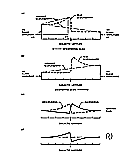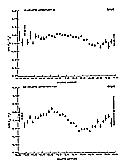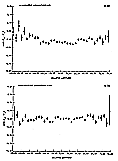IRAS Explanatory Supplement
VI. Flux Reconstruction and Calibration
B. Determination of Relative Flux
B.4 Problems
Table of Contents | Index | Previous Section | Next Section
- Rejected Internal Reference Source Flashes
- Radiation
- Photon Induced Responsivity Enhancement
- Variation of Frequency Response with Total Flux
B.4.a Rejected Internal Reference Source Flashes
The ability to extract an accurate measure of the amplitude of the internal reference source flash was complicated because of the structure of the sky over which the internal reference source was flashed. In particular, a good measure of the baseline accompanying the flash was required. The difficulty in extracting this information increased as the complexity of the sky emission increased. Several checks were implemented in the software to assure that an unreliable internal reference source measurement was rejected.
Errors could arise if extrapolations had to be made over a rejected flash to the next available one and also if an internal reference source flash was accepted but should have been rejected. This usually occurred when the majority of internal reference source measurements in a band were rejected due to complex sky background, but one or two slipped past the threshold checks in the software. Reference flashes were rejected in fewer than 7% of survey scans and this usually occurred at 60 or 100 µm. The photometric error associated with the extrapolation to the next available reference outside the current scan is estimated to be less than 5% in the 12, 25, and 60 µm bands. In the 100 µm band possible photon induced responsivity enhancement (Section IV.A.8 and VI.B.4.c) may result in photometric errors up to 15%. The error associated with the use of reference flashes which should have been rejected is estimated to be less than 10% at 12 and 25 µm and less than 20% at 60 and 100 µm.
B.4.b Radiation
The flux reconstruction took into account the effects of the bias boost by making sure that no detector's responsivity was interpolated across a bias boost event and by implementing a model to account for the time dependent exponential baseline decay after the bias boost event. Any linear change in the responsivity after a bias boost was corrected by the interpolation between reference flashes, but residual nonlinear responsivity variations and changes associated with low level radiation exposure, such as at the polar horns, were ignored in the flux reconstruction process. It is estimated that not accounting for radiation exposure should introduce an uncertainty of less than a few percent in the data.
B.4.c Photon Induced Responsivity Enhancement
B.4.c.1Point Sources
As discussed in Section IV.A.8, analysis after the mission showed that passage over a bright infrared source such as Saturn or, more typically, the Galactic plane increased the responsivity of the 100 µm detectors by as much as 15%. The enhancement decayed with a long but unknown time constant, thus invalidating the basic assumption of a linear change in the responsivity in the time between flashes of the internal reference source.
 |
|
Figure VI.B.2 A schematic representation of the effects of photon
induced responsivity enhancement. Sketches (a) and
(b) show the true and assumed responsivity for
ascending and descending scans. It is seen that if the
first flash of the internal reference source occurs
before the plane crossing, the sign of the effect is
reversed from the case when it occurs after the plane
crossing. Sketches (c) and (d) show the effect on the
quoted fluxes and on the ratio of fluxes obtained on
descending and ascending scans. larger largest |
The sign and magnitude of the effects of photon induced responsivity
enhancement on the photometry depends crucially on the relative location
of the detected source, on the location of the bright source of infrared
radiation, i.e., of the Galactic plane, and on the time of the flashes
of the internal reference source relative to the bright source exposure.
This is illustrated in Fig. VI.B.2. As an example,
if the flashes occurred far from the Galactic plane, (flashes (3) and (1)
in Fig. VI.B.2.a), the flux of sources located
on the trailing side of the plane would be overestimated and sources on
the leading side of the plane would be underestimated. On the other hand,
if the flash occurred near the Galactic plane, (e.g., as shown in
Fig. VI.B.2.a with flashes (2) and (1)) the linear
interpolation of the responsivity would lead to an underestimate of the flux
of the same source.
 |
|
Figure VI.B.3 Results of comparisons of fluxes at 100 µm of
sources observed on descending and ascending
scans for sources within the ecliptic longitudes
indicated. The ordinate is log(FD/FA) where FA
is the flux found on ascending scans and FD is
the flux found on descending scans. larger largest |
The enhancement had not been measured or modeled before flight. In principle,
this effect could be accounted for on a scan by scan basis by calculating
a nonlinear time history for the responsivity between flashes of the internal
reference source. In practice, however, because the effect was discovered
only after a significant amount of processing was completed, it was not
possible to make a proper correction for this effect, and a statistical
approach was taken. The basis of the approach is to assume that a series
of scans were laid down with sufficient regularity that on the average
a given area of the sky relative to the Galactic plane was affected uniformly.
for example, if the flashes were all taken sufficiently far from the plane
that the effects of the enhancement had decayed, the observed fluxes would
resemble those in Fig. VI.B.2.c. The ratio of fluxes
observed on descending scans to those seen on ascending scans would then
be as indicated in Fig. VI.B.2.d. Such a signature
was in fact observed at a number of ecliptic longitudes; see
Fig. VI.B.3.
 |
|
Figure VI.B.4 Areas of sky in ecliptic coordinates which have more
than 50 sources observed at 100 µm in both
descending and ascending scans. The measure of the
photon induced responsivity enhancement, log(FD/FA)
is indicated by the cross hatches. larger largest |
Unfortunately, a significant area of the sky was not covered with overlapping
descending and ascending scans. The areas which were covered with scans
in both directions and for which  50 sources
were found in bins 20°
× 5° in ecliptic longitude and latitude are indicated in
Fig. VI.B.4. On the basis of this figure, a correction
factor was assigned at the locations where at least 50 overlapping values of
FD and FA, the fluxes measured on
descending and ascending scans were measured. The asymmetry
about the Galactic plane seen in the figure is a result of the manner in
which the survey scans were made. for example, at ecliptic longitudes 60°
to 160°, some of the descending scans ended prior to crossing the Galactic
plane giving virtually no responsivity enhancement while other descending
scans crossed the plane resulting in significant responsivity enhancement.
Likewise the same affect occurs for the ascending scans between ecliptic
longitudes of 240° to 340°, giving lower corrections for the negative
Galactic latitudes. The correction was quanitized into four non-zero values,
± 2.5% and ±7.5% on the basis of the value of
log (FD/FA), shown in
Fig. VI.B.4. An arbitrary extrapolation of these
correction factors was assumed for areas where sufficient coverage by both
ascending and descending scans was missing; the resulting corrections are
shown in Fig. VI.B.5. Subsequently, the correction
was applied to each source found at 100 µm on a descending scan
and its negative was applied to the sources found at 100 µm
on ascending scans whether or not it was in a region of overlapping ascending
and descending scans. Clearly this procedure is very approximate.
Figure VI.B.6 shows the results of applying these
corrections to the same observations presented in
Fig. VI.B.3.
50 sources
were found in bins 20°
× 5° in ecliptic longitude and latitude are indicated in
Fig. VI.B.4. On the basis of this figure, a correction
factor was assigned at the locations where at least 50 overlapping values of
FD and FA, the fluxes measured on
descending and ascending scans were measured. The asymmetry
about the Galactic plane seen in the figure is a result of the manner in
which the survey scans were made. for example, at ecliptic longitudes 60°
to 160°, some of the descending scans ended prior to crossing the Galactic
plane giving virtually no responsivity enhancement while other descending
scans crossed the plane resulting in significant responsivity enhancement.
Likewise the same affect occurs for the ascending scans between ecliptic
longitudes of 240° to 340°, giving lower corrections for the negative
Galactic latitudes. The correction was quanitized into four non-zero values,
± 2.5% and ±7.5% on the basis of the value of
log (FD/FA), shown in
Fig. VI.B.4. An arbitrary extrapolation of these
correction factors was assumed for areas where sufficient coverage by both
ascending and descending scans was missing; the resulting corrections are
shown in Fig. VI.B.5. Subsequently, the correction
was applied to each source found at 100 µm on a descending scan
and its negative was applied to the sources found at 100 µm
on ascending scans whether or not it was in a region of overlapping ascending
and descending scans. Clearly this procedure is very approximate.
Figure VI.B.6 shows the results of applying these
corrections to the same observations presented in
Fig. VI.B.3.
 |
|
Figure VI.B.5 The correction factors, assigned on the basis of
Fig. VI.B.4, used to correct for the photon-induced
responsivity enhancement at 100 µm. See text. larger largest |
 |
|
Figure VI.B.6 The same observations as in
Figure VI.B.3, but with
the fluxes corrected using the correction factors of
Figure VI.B.5 larger largest |
Extended Emission
The effects of photon induced responsivity enhancement on the extended emission data were observed by comparing, pixel by pixel, low resolution (0.5° square pixels) maps of the first sky coverage to the last sky coverage. Photon induced responsivity enhancement from bright portions of the Galactic plane appears to affect the extended emission in both the 60 and 100 µm bands to a larger extent than it does the point sources.
This problem has not been well enough understood at the release of this catalog (November 1984) to properly remove the effect. No correction has been applied to the quoted surface brightnesses, but separate data sets for the three sky coverages have been produced. When all of these data sets are released the user will be able to determine if photon induced responsivity enhancement effects are important in a particular area of interest. The zodiacal history file (Section X.D.6) should be consulted to determine if the different sky coverages did indeed cover the area in different directions.
B.4.d Variation of Frequency Response
with Total Flux
The observations shown in Fig. IV.A.4
indicate that in the 60 and 100 µm bands, at least, the frequency
response depends on the brightness of the source. The observations have
not been analyzed in detail, but sources up to ten times brighter than
 -Lyr apparently follow the pattern shown by
-Lyr apparently follow the pattern shown by  -Lyr. It is not clear whether
the change for brighter sources comes in the point source response at survey
rate or in the low frequency responsivity. Thus the photometry of all sources
brighter than about 100 Jy at 60 or 100 µm has uncertainties
ranging to 30% at 60 µm and 70% at 100 µm that are
not understood. This caution must apply equally to the extended emission
aliases and to the small extended sources where the variations in the responsivity
with frequency apparently change sign in going from weak to bright sources
and from point sources to regions of large scale emission.
-Lyr. It is not clear whether
the change for brighter sources comes in the point source response at survey
rate or in the low frequency responsivity. Thus the photometry of all sources
brighter than about 100 Jy at 60 or 100 µm has uncertainties
ranging to 30% at 60 µm and 70% at 100 µm that are
not understood. This caution must apply equally to the extended emission
aliases and to the small extended sources where the variations in the responsivity
with frequency apparently change sign in going from weak to bright sources
and from point sources to regions of large scale emission.
Chapter Contents | Introduction | Authors | References
Table of Contents | Index | Previous Section | Next Section